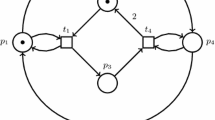Abstract
We construct r-nets of many different orders which have no ovals and r-nets of many other orders which have no hyperovals.
Similar content being viewed by others
References
Th. Beth, D. Jungnickel and H. Lenz, Design theory. In Encyclopedia of Mathematics and its Applications, Vol. 69, Cambridge University Press, Cambridge, second edition (1999).
P. J. Cameron, Parallelisms of complete designs. In London Math. Soc. Lecture Note Series, Vol. 23, Cambridge University Press, Cambridge (1976).
C. J. Colbourn and J. H. Dinitz (eds), The CRC Handbook of Combinatorial Designs, CRC Press, Boca Raton (1996).
C. J. Colbourn, D. A. Drake and W. Myrvold, Ovals and hyperovals in nets, Discrete Math., to appear.
P. Dembowski, Finite Geometries. In Ergebnisseder Math. u. ihrer Grenzgebiete, Vol. 44, Springer-Verlag, New York (1968).
J. Déenes and A. D. Keedwell, Latin Squares and Their Applications, The English Universities Press, London, England (1974).
R. H. F. Denniston, Remarks on Latin squares with no subsquares of order two, Utilitas Math, Vol. 13 (1978) pp. 299–302.
D. A. Drake, Hyperovals in nets of small degree, J. Combinatorial Designs, Vol. 10 (2002) pp. 322–334.
D. A. Drake, Desarguesian Nets Without Ovals, preprint, University of Florida (2003).
D. A. Drake and K. Keating, Ovals and hyperovals in Desarguesian nets, Designs, Codes and Cryptography, to appear.
D. A. Drake and W. Myrvold, The non-existence of maximal sets of four mutually orthogonal Latin squares of order 8, Designs, Codes and Cryptography, to appear.
K. Heinrich and W. D. Wallis, The maximum number of intercalates in a Latin square, Combinatorial Mathematics, VIII (Geelong, 1980). In Lecture Notes in Math., Vol. 884, Springer, Berlin-New York (1981) pp. 221–233.
A. Kotzig, C. C. Lindner and A. Rosa, Latin squares with no subsquares of order two and disjoint Steiner triple systems, Utilitas Math., Vol. 7 (1975) pp. 287–294.
A. Kotzig and J. Turgeon and E. Regener, On certain constructions for Latin squares with no Latin subsquares of order two, Discrete Math., Vol. 16 (1976) pp. 263–270.
C. W. H. Lam, L. Thiel and S. Swiercz, The non-existence of finite projective planes of order 10, Canadian J. Math., Vol. 41 (1989) pp. 1117–1123.
T. Y. Lam, A first course in noncommutative rings. In Graduate Texts in Mathematics, Springer-Verlag, New York, second edition (2001).
M. McLeish, A direct construction of Latin squares with no subsquares of order two, Ars Combin., Vol. 10 (1980) pp. 179–186.
T. Penttila, G. F. Royle and M. K. Simpson, Hyperovals in the known projective planes of order 16, J. Combinatorial Designs, Vol. 4 (1996) pp. 59–65.
G. J. Simmons, Sharply focused sets of lines on a conic in PG(2, q), Congressus Numerantium, Vol. 73 (1990) pp. 181–204.
D. T. Todorov, Three mutually orthogonal Latin squares of order 14, Ars Combin., Vol. 20 (1985) pp. 45–48.
I. M. Wanless, On McLeish's construction for Latin squares without intercalates, Ars Combin., Vol. 58 (2001) pp. 313–317.
Author information
Authors and Affiliations
Rights and permissions
About this article
Cite this article
Drake, D.A., Myrvold, W. Nets of Small Degree Without Ovals. Designs, Codes and Cryptography 32, 167–183 (2004). https://doi.org/10.1023/B:DESI.0000029220.27696.d0
Issue Date:
DOI: https://doi.org/10.1023/B:DESI.0000029220.27696.d0



